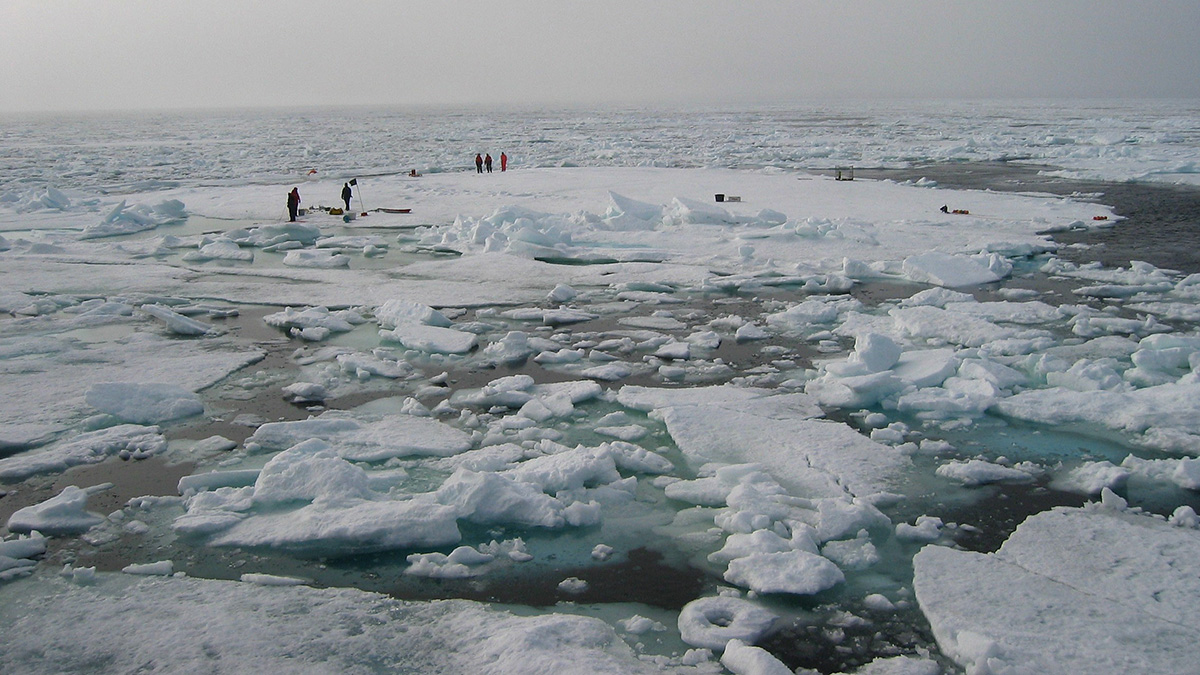The underside of sea ice in the Arctic is almost like the seafloor turned upside down—and covered with a biofilm of microorganisms and algae. As sea ice melts during the summer and forms melt ponds on its surface, some of the algae find their way into the ponds and the cracks between the ice, forming buoyant little mats on the surface.
“What [the polar bears] eat also needs to eat something that needs to eat something, and everything starts from the algae.”
A recent study published in Frontiers in Marine Science showed that these mats have very high photosynthetic activity, suggesting that they might be an important, underexplored element of the Arctic food web.
How can microscopic algae support everything from ciliates to cod to the Arctic’s largest terrestrial predator? “The polar bears are only there because there is food for them somehow,” explained lead author Kasper Hancke, a researcher at the Norwegian Institute for Water Research. “What they eat also needs to eat something that needs to eat something, and everything starts from the algae.”
Ice Algae in the Arctic Food Web
Researchers have known about ice algae for a long time. Legendary Norwegian explorer Fridtjof Nansen described them during his historic 1893 expedition, in which he intentionally froze his ship in Arctic sea ice in the hopes of reaching the North Pole. (It didn’t work.)
During the following century, however, ice algae fell into relative oblivion. In 2004, Hancke was studying carbon flows in the Barents Sea for his doctoral research when he came across the small mats floating in sea ice melt ponds. He was intrigued and used his equipment to measure their primary production and carbon turnover. When he presented his data to his supervisors at the time, however, they didn’t think his research deserved attention.

Over the next 2 decades, research efforts on ice algae increased, prompting Hancke to finally publish his results. His measurements showed very high rates of photosynthetic activity in the mats, higher than any other figure published for ice algae before. This activity is important because the carbon the algae produce feed the next level of the food chain—tiny grazers such as ciliates that Hancke found associated with the mats. The grazers are then eaten by amphipods, which are eaten by polar cod. Seals rely on the cod and other fish for food, and the seals themselves are eaten by polar bears, completing a food chain.
“The study adds a new aspect to this environment,” said Philipp Assmy, a researcher at the Norwegian Polar Institute who was not involved in the research. Assmy found similar algal aggregates back in 2012 during a cruise to the eastern central Arctic. In his study, Hancke used oxygen microelectrodes, which is a first for ice algal mats. “With these [microelectrodes], they were able to measure primary production on really fine scales inside the aggregates,” said Assmy, “which we weren’t able to do.”
Ice Algae in the Warming Ocean
The Arctic is warming at a rate 2–4 times faster than the global average, resulting in thinning and disappearing ice, with melt ponds currently covering as much as 60% of sea ice area during the summer months. “There is clear evidence that there are more and more melt ponds, which means that the habitat for these ice algae mats might be increasing,” said Hancke. “They could potentially be more important in the future with global warming.”
“Once [the algae] sink to the seafloor, there’s basically no return ticket.”
Although more melt ponds might mean more floating algal mats, if in the future the sea ice melts completely during the summer (a distinct possibility), the recruitment of the algae could become compromised. In the winter, algae freeze into the ice and repopulate the ponds during melting in the summer. If there is no ice present, the mats might lose their buoyancy and sink into the abyss. And “once they sink to the seafloor, there’s basically no return ticket,” said Assmy.
Because of their role in the food web, learning more about ice algae and deciphering their fate on our warming planet could be important for the entire Arctic ecosystem. “If I am to do something in the future and get the opportunity, I would bring a set of drones with algae-specific cameras and fly over these areas to try to detect and quantify their spatial distribution,” said Hancke. That distribution “is a puzzle piece that is needed to address how important they are.”
—Fanni Daniella Szakal (@FanniDaniella), Science Writer

